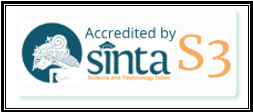Gambaran Efikasi Diri Pada Penyandang Disabilitas Daksa Usia Remaja
DOI:
https://doi.org/10.22515/ajpc.v3i1.4689Keywords:
adolescents, people with physical disabilities, self-efficacyAbstract
The life of an adolescents who will come is largely determined by the efficacy that is in him, how much the individual believes in his abilities.This study aims to find out how self-efficacy is in adolescents with physical disabilities, the type of research used is a qualitative case study. The technique of determining the subject is purposive sampling. The subjects in this study were three adolescents with physical disabilities in the Sehati Sukoharjo and family members of the main subject as supporting subjects. Data collection techniques using interviews. The validity of the data using source triangulation.
The results of this study provide an overview of self-efficacy in adolescents with physical disabilities at the Sukoharjo Sehati Difabel Association. At the level aspect (level) is indicated by action, determination, confidence in self-ability, trust from the environment. Aspects of strength (strength) are shown by optimistic thinking, role models, recognition from the environment, previous self-competence, and emotional management. The generality aspect is shown by increasing skills and levels, solution strategies, and self-development with references.
Downloads
References
Adelina, F., Akhmad, S. K., & Hadi, C. (2018). Bagaimana Agar Penyandang Tuna Daksa Mampu Menjadi Pribadi Yang Bahagia? Jurnal Sains Psikologi, 7(2), 119–125. https://doi.org/10.17977/um023v7i22018p119
Adi, B. E., Karini, S. M., & Anggarani, F. K. (2021). Studi Fenomenologi: Ketangguhan (Hardiness) Pada Wanita Dewasa Penyandang Disabilitas Tunanetra Yang Berwirausaha. Wacana, 13(1), 37–52. https://doi.org/10.13057/wacana.v13i1.178
Alwisol. (2009). Psikologi Kepribadian. Malang: UMM Press.
Anderson, S. L., & Betz, N. E. (2001). Sources Of Social Self-Efficacy Expectations: Their Measurement And Relation To Career Development. Journal of Vocational Behavior, 58(1), 98–117. https://doi.org/10.1006/jvbe.2000.1753.
Astuti, R., & Gunawan, W. (2017). Sumber-Sumber Efikasi Diri Karier Remaja. Jurnal Psikogenesis, 4(2), 141-151. https://doi.org/10.24854/jps.v4i2.348
Bandura, A. (1977). Self-Efficacy: Toward A Unifying Theory Of Behavioral Change. Psychological Review, 84(2), 191–215. https://doi.org/10.1037/0033-295X.84.2.191
Bandura, A. (2017). Self Efficacy: The Exereire Of Control. New York, United States: W.H. Freeman and Company.
Febriani, I. (2018). Penerimaan Diri Pada Remaja Penyandang Tuna Daksa. Psikoborneo: Jurnal Ilmiah Psikologi, 6(1), 150–157. https://doi.org/10.30872/psikoborneo.v6i1.4539
Feist, J., Feist, G. J., & Roberts, T.-A. (2017). Theories Of Personality (8th Ed). New York, USA: McGraw-Hill Education (Asia).
Ghufron, M. N., & Risnawati, R. (2012). Teori-Teori Psikologi. Yogyakarta: Ar-Ruzz.
Gumilang, G. S. (2016). Metode Penelitian Kualitatif Dalam Bidang Bimbingan Dan Konseling. Fokus Konseling, 2(2), 144-159. https://doi.org/10.52657/jfk.v2i2.218
Harumi, B. P. Y., & Marheni, A. (2018). Peran Konsep Diri Dan Efikasi Diri Terhadap Kematangan Karier Mahasiswa Fakultas Kedokteran Unviversitas Udayana. Jurnal Psikologi Udayana, 5(1), 23-34. https://doi.org/10.24843/jpu.2018.v05.i01.p03
Herdiansyah. (2014). Metodologi Penelitian Kualitatif Untuk Ilmu-Ilmu Sosial. Jakarta: Selemba Humanika.
Hidayatullah, N., & Pranowo. (2018). Providing More Hope And Welfare For Persons With Disabilities. Jurnal PKS, 17(2), 195–206.
Kementerian Kesehatan RI. (2014). Situasi Penyandang Disabilitas. Jakarta: Kementerian Kesehatan RI.
Kreitner, R., & Kinicki, A. (2014). Perilaku Organisasi (9th Ed., Vol. 1). Jakarta: Salemba Empat.
Lestari, T. R., Adyas, A., Rachmawati, E., Ardesa, Y. H., & Pasaribu, E. S. (2018). Kekuatan Dan Kesulitan Remaja Disabilitas Di Yayasan Pendidikan Anak Cacat (YPAC) Jakarta Dan Surakarta. Jurnal Kesehatan, 9(2), 248-252. https://doi.org/10.26630/jk.v9i2.898
Mahmudi, M. H., & Suroso, S. (2014). Efikasi Diri, Dukungan Sosial Dan Penyesuaian Diri Dalam Belajar. Persona: Jurnal Psikologi Indonesia, 3(2), 183–194. https://doi.org/10.30996/persona.v3i02.382
Mappiare, A. (2017). Psikologi Orang Dewasa. Surabaya: Usaha Nasional.
Miraghaei, S. Z., & Azar, Z. A. (2017). Comparing Life Quality Strategies And Emotion Regulation In People With Congenital And Non-Conggenital Motor Disability. International Journal Of Medical Research & Health Sciences, 6(10), 105–110.
Mukti, B., & Tentama, F. (2019). Faktor-Faktor Yang Mempengaruhi Efikasi Diri Akademik. Prosiding Seminar Nasional Magister Psikologi Universitas Ahmad Dahlan, 0(0), 341–347. Magister Psikologi Universitas Ahmad Dahlan.
Nanda, A., & Widodo, P. (2015). Efikasi Diri Ditinjau Dari School Well-Being Pada Siswa Sekolah Menengah Kejuruan Di Semarang. Jurnal Empati, 4(4), 90–95. https://doi.org/10.14710/empati.2015.13662
Ndaumanu, F. (2020). Hak Penyandang Disabilitas: Antara Tanggung Jawab Dan Pelaksanaan Oleh Pemerintah Daerah. Jurnal HAM, 11(1), 131-150. https://doi.org/10.30641/ham.2020.11.131-150
Ningsih, F., & Susanti, S. S. (2019). Psychological Well-Being Pada Penyandang Disabilitas Fisik. Jurnal Imiah Mahasiswa Fakultas Keperawatan, 4(1), 87–94.
Rachmansyah. (2018). Memupuk Rasa Percaya Diri. Jakarta: Bumi Aksara.
Rustika, I. M. (2012). Efikasi Diri: Tinjauan Teori Albert Bandura. Buletin Psikologi, 20(1–2), 18–25. https://doi.org/10.22146/bpsi.11945
Santrock, J. W. (2008). Child Development (Terj: Rahmawati dan Kuswanti) (11th Ed.). Jakarta: Penerbit Erlangga.
Sugiyono. (2018). Metode Penelitian Pendekatan Kualitatif. Bandung: Alfabeta.
Virlia, S., & Wijaya, A. (2015). Penerimaan Diri Pada Gangguan Citra Diri. Seminar Psikologi & Kemanusiaan, (4), 978–979.
WHO. (2016). Dissability And Health. www.who.int/mediacenter/Factsheets/Fs 352/en/.
Wibowo, A. A. (2020). Efikasi Diri Atlet Panjat Tebing Difabel (Skripsi: Tidak Dipublikasikan). Surakarta: Universitas Muhammadiyah Surakarta.
Downloads
Published
How to Cite
Issue
Section
Citation Check
License
Copyright (c) 2022 Alfia Zahri, Vera Imanti

This work is licensed under a Creative Commons Attribution-NonCommercial 4.0 International License.
Authors who publish with this journal agree to the following terms:
- Authors retain copyright and grant the journal right of first publication with the work simultaneously licensed under a Creative Commons Attribution-NonCommercial 4.0 International License that allows others to share the work with an acknowledgement of the work's authorship and initial publication in this journal.
- Authors are able to enter into separate, additional contractual arrangements for the non-exclusive distribution of the journal's published version of the work (e.g., post it to an institutional repository or publish it in a book), with an acknowledgement of its initial publication in this journal.
- Authors are permitted and encouraged to post their work online (e.g., in institutional repositories or on their website) prior to and during the submission process, as it can lead to productive exchanges, as well as earlier and greater citation of published work.










